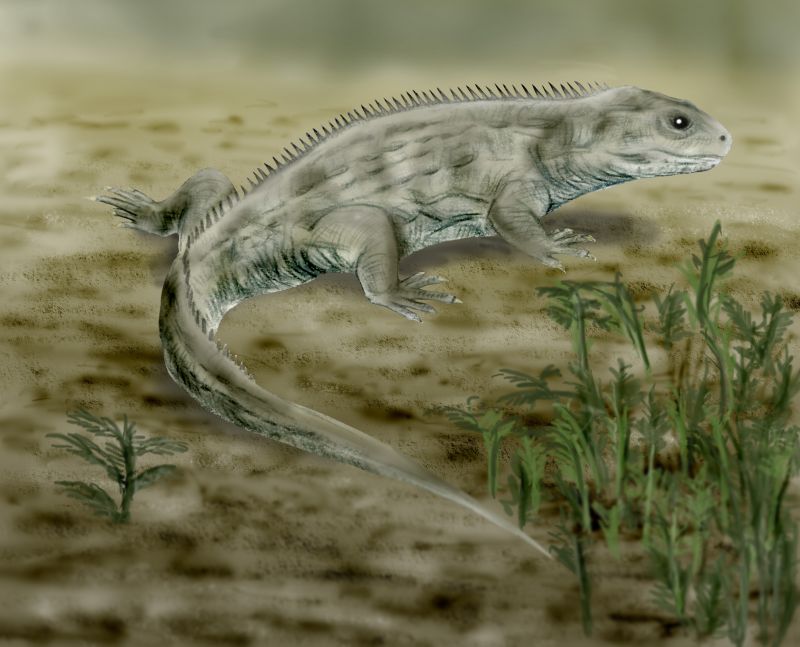Brachyrhinodon on:
[Wikipedia]
[Google]
[Amazon]
''Brachyrhinodon'' (meaning "short nose tooth") is an
 ''Brachyrhinodon'' is known from remains covering most of the skeleton. The skull of ''Brachyrhinodon'' is around long. The skull is relatively blunt. The front of the upper jaw overhangs the front of the lower jaw. The teeth are conical. The postcranial skeleton is similar to that of other sphenodontians.
''Brachyrhinodon'' is known from remains covering most of the skeleton. The skull of ''Brachyrhinodon'' is around long. The skull is relatively blunt. The front of the upper jaw overhangs the front of the lower jaw. The teeth are conical. The postcranial skeleton is similar to that of other sphenodontians.
Palaeoecology, taphonomy and dating of Permo-Triassic reptiles from Elgin, north-east Scotland
''Palaeontology'', 28 (1985), pp. 207-234
extinct
Extinction is the termination of an organism by the death of its Endling, last member. A taxon may become Functional extinction, functionally extinct before the death of its last member if it loses the capacity to Reproduction, reproduce and ...
genus
Genus (; : genera ) is a taxonomic rank above species and below family (taxonomy), family as used in the biological classification of extant taxon, living and fossil organisms as well as Virus classification#ICTV classification, viruses. In bino ...
of sphenodontian from the Late Triassic
The Late Triassic is the third and final epoch (geology), epoch of the Triassic geologic time scale, Period in the geologic time scale, spanning the time between annum, Ma and Ma (million years ago). It is preceded by the Middle Triassic Epoch a ...
Lossiemouth Sandstone of Scotland
Scotland is a Countries of the United Kingdom, country that is part of the United Kingdom. It contains nearly one-third of the United Kingdom's land area, consisting of the northern part of the island of Great Britain and more than 790 adjac ...
.
History of discovery
''Brachyrhinodon'' and its single species ''B. taylori'' originally described in 1910 by German paleontologist Friedrich von Huene based on three specimens found near Elgin, Scotland where a number of reptile fossils (collectively dubbed the " Elgin Reptiles") have been found. The species was later redescribed in 1989 based on 12 specimens, representing at least 10 individuals. The specimens are largely preserved as negative moulds within the sandstone, which meant that casts needed to be made for description.Description
Taxonomy
''Brachyrhinodon'' is considered to be a member of Eusphenodontia. Some studies have recovered it as closely related to ''Clevosaurus
''Clevosaurus'' (meaning "Gloucester lizard") is an extinct genus of rhynchocephalian reptile from the Late Triassic and the Early Jurassic periods. Species of ''Clevosaurus'' were widespread across Pangaea, and have been found on all continents ...
,'' placing both genera as part of the family Clevosauridae
Clevosaurs are an Extinction, extinct group of rhynchocephalian reptiles from the Triassic and Jurassic periods.
History and definition
Although members of this group have been known since 1910, only recently has the group received a formal n ...
, with some studies finding ''B. taylori'' nested within ''Clevosaurus''. Other studies have recovered ''Brachyrhinodon'' as unrelated to ''Clevosaurus''.
Ecology
A 1985 paper suggested anomnivorous
An omnivore () is an animal that regularly consumes significant quantities of both plant and animal matter. Obtaining energy and nutrients from plant and animal matter, omnivores digest carbohydrates, protein, fat, and fiber, and metabolize ...
diet.M.J. Benton, A.D. WalkePalaeoecology, taphonomy and dating of Permo-Triassic reptiles from Elgin, north-east Scotland
''Palaeontology'', 28 (1985), pp. 207-234

References
Triassic lepidosaurs Triassic reptiles of Europe Rhynchocephalia Prehistoric reptile genera {{triassic-reptile-stub